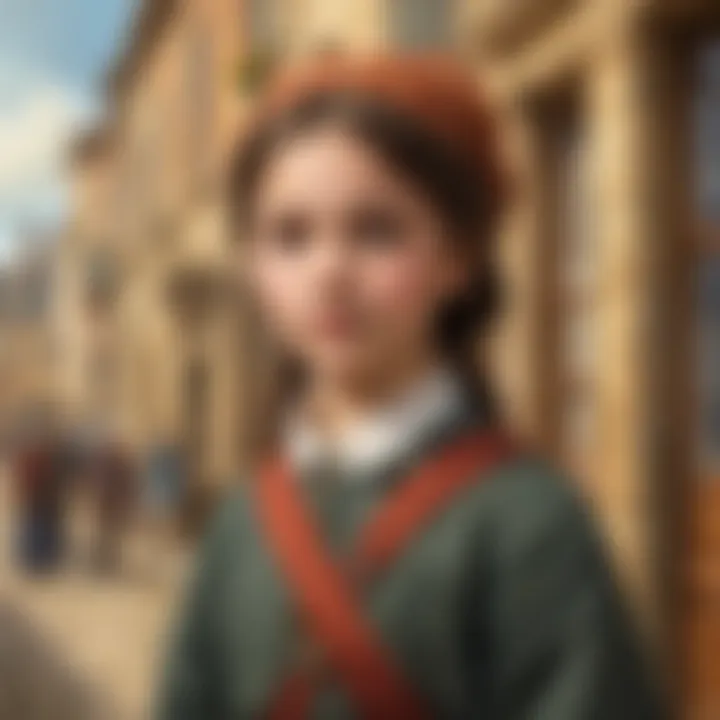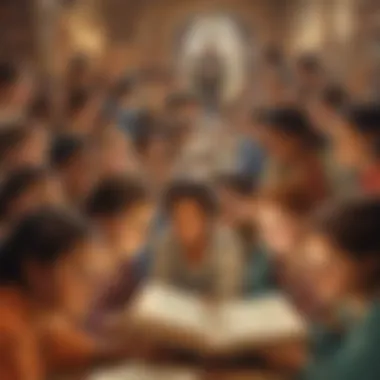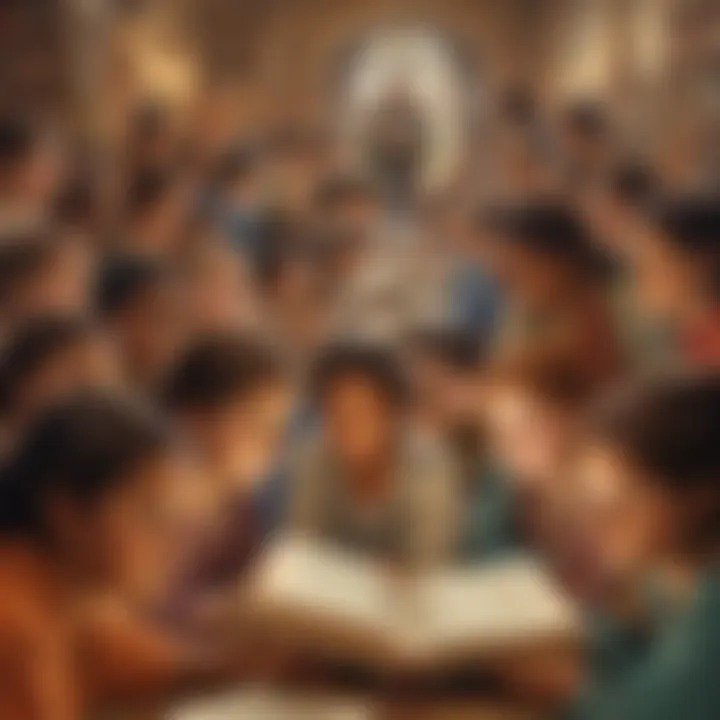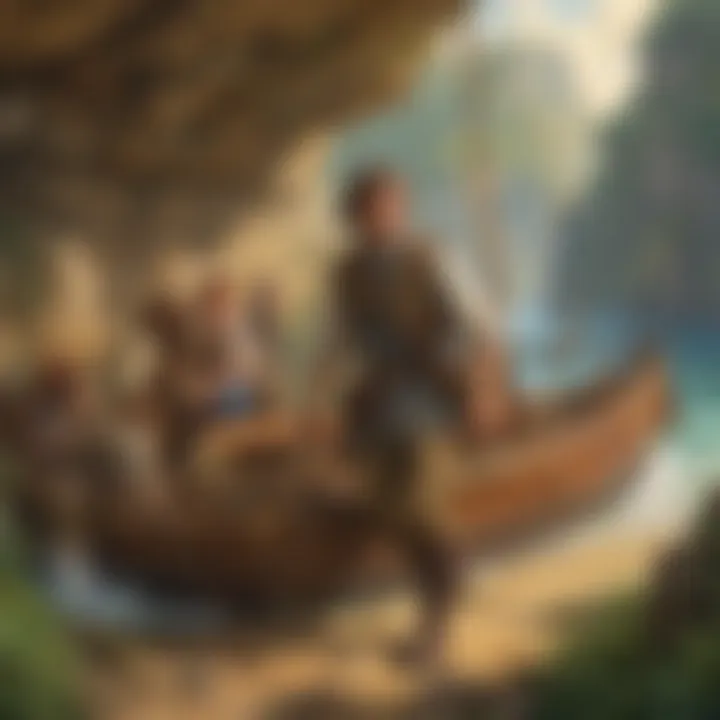Engaging Historical Fiction Books for 12-Year-Olds


Intro
Historical fiction serves as a bridge connecting young readers to the past. It enables them to experience history in a way that textbooks often cannot. By diving into the lives of characters from different eras, 12-year-olds develop a sense of empathy and curiosity about the events that shaped our world. This genre not only provides entertainment but also can inspire further exploration of historical topics.
In this article, we will discuss various aspects of historical fiction that make it suitable for children around the age of twelve. We will look at some engaging titles, the themes that are commonly explored, and the benefits of this genre in fostering a deeper understanding of history. This discourse will serve as a valuable resource for parents, educators, and young readers seeking to enhance their literary experiences.
Creative Activities
Engaging in creative activities related to historical fiction enhances understanding and retention of the themes, characters, and settings found in these books. Here are some ideas that children can easily replicate.
Craft Ideas
- Timeline Posters: Have children create timelines that depict the historical events featured in their chosen books. This visual representation helps them understand the sequence of events.
- Character Masks: Encourage kids to make masks representing characters from their favorite historical fiction. This encourages imagination and engagement with the text.
- Letter Writing: Ask children to write letters from the perspective of a character in the story. This deepens their connection to the story and offers insights into the character's motivations.
Step-by-Step Guides
- Creating a Timeline Poster:
- Making Character Masks:
- Letter Writing:
- Gather materials like poster board, markers, and images.
- Research key events from the book.
- Lay out a timeline on the poster board.
- Add illustrations and brief descriptions of each event.
- Start with a paper plate.
- Design and color the mask based on book characters.
- Cut out holes for eyes, and attach a stick for holding.
- Choose a character from a kept book.
- Write a letter expressing their thoughts or feelings after an important event in the story.
- Share the letters with friends or family.
Educational Value
These activities are not just about crafting. They have educational value as well. They promote critical thinking, enhance comprehension, and foster a discussion about the historical context of the narratives. Engaging with the material through different mediums solidifies young readers' knowledge and appreciation for historical fiction.
Fun Quizzes
Quizzes are an excellent way to assess understanding while making learning enjoyable. Here is an outline of the fun quizzes that relate to historical fiction.
Quiz Topics
Some quizzes could cover topics such as:
- Key events from the books.
- Character traits and choices.
- Important historical figures mentioned in the stories.
Question Types
In the quizzes available, you'll find a variety of question types. They may include:
- Multiple-choice questions.
- True or false statements.
- Short answer questions encouraging detailed responses.
Knowledge Reinforcement
Quizzes help reinforce what children learn from historical fiction books. They encourage recall and application of knowledge, making the reading experience more memorable.
Fact-Based Articles
Reading fact-based articles can complement the fictional narratives and provide context.
Topics
The articles may cover a range of topics such as:
- Significant historical events.
- Biographies of historical figures.
- Cultural practices within different time periods.
Engaging Content
These articles typically present information in an engaging manner. They often use clear language and visuals to make complex concepts understandable for young readers.


Intro to Historical Fiction
Historical fiction serves as a portal into the past, bridging gaps in time and culture for young readers. This genre allows them to engage with historical events through the lens of storytelling. As young minds explore these narratives, they encounter pivotal moments in history wrapped in relatable characters and compelling plots. This section dives deep into what defines historical fiction and highlights its significance for children, particularly those around 12 years of age.
Defining Historical Fiction
Historical fiction is a literary genre where the narrative is set in the past, often incorporating real historical events, figures, and timelines. The key characteristic of this genre is its adherence to a historical setting while allowing creative storytelling. Authours often take liberties with facts to enhance the plot or develop characters. However, a strong foundation in historically accurate elements is crucial.
For example, books set during significant historical periods, like the American Civil War or World War II, weave genuine events into fictional tales to create gripping stories. Readers not only enjoy a riveting plot but also learn about the nuances of history through these carefully constructed narratives. The blending of fact with fiction makes historical fiction a unique tool for educational exploration.
Importance of Historical Fiction for Young Readers
Literature plays an important role in shaping young minds, and historical fiction should not be underestimated in this regard. For readers around 12, this genre is more than just entertainment; it offers several benefits.
First, engaging with historical fiction helps develop critical thinking skills. Children begin to question, analyze, and draw connections between past and present. This kind of engagement prompts discussions about societal structures, motivations behind conflicts, and different cultural perspectives.
Second, reading historical fiction fosters empathy. By stepping into the shoes of diverse characters, readers can better understand the struggles and dreams of people from different backgrounds. Such narratives expose children to varied experiences that promote inclusivity and build a more complex worldview.
Finally, this genre encourages historical awareness. Young readers become more informed about significant events, movements, and milestones in history. They learn about various cultures and can appreciate the multifaceted nature of the human experience.
"Historical fiction allows young readers to experience past cultures and events, instilling a deeper understanding of history and its relevance today."
In summary, historical fiction plays a crucial role in encouraging young readers to engage with history. It helps them develop critical skills and understand the richness of diverse perspectives through well-crafted narratives.
Benefits of Reading Historical Fiction
Reading historical fiction offers various benefits, especially for young readers. These narratives go beyond entertainment; they provide critical learning tools. The genre encourages children to engage with the past, promoting both educational and personal growth. Children at the age of twelve are at a pivotal stage of development. Thus, introducing them to historical fiction can lay the groundwork for their future understanding of history, society, and themselves.
Enhancing Critical Thinking Skills
One of the key benefits of reading historical fiction is its ability to enhance critical thinking skills. When young readers immerse themselves in stories set in different time periods, they encounter complex situations and decisions. They are often prompted to consider the motivations of characters, the context of events, and potential consequences. This requires them to analyze information and develop their interpretations.
Historical fiction asks young minds to question — What would I have done in this situation?
This engagement cultivates analytical thinking. Children learn to devise reasoned arguments based on the evidence presented in the text. They may also recognize patterns or themes that resonate with contemporary issues, thus providing a bridge to modern social reflections.
Fostering Empathy and Understanding
Another significant advantage of historical fiction is its ability to foster empathy. Through stories about diverse characters facing various challenges, readers gain insights into different lives. For instance, a child reading about a protagonist in World War II will understand the fears and struggles of that time. This can lead to greater compassion for individuals in similar situations today.
The emotional connection formed with characters allows young readers to explore feelings and experiences outside of their own. It helps them appreciate diverse perspectives and navigate relationships with people from different backgrounds. Empathy derived from literature can translate into real-life interactions, encouraging inclusion and kindness.
Encouraging Historical Awareness
Lastly, historical fiction serves as a key tool for encouraging historical awareness. While history textbooks present facts and dates, fiction brings those details to life. Tales of bygone eras create vivid images in the minds of young readers. They learn not just about events but also about the culture, values, and social structures of different times.
When readers discover historical contexts through rich narratives, events become more meaningful. For example, experiencing the civil rights movement through the eyes of a fictional child may resonate more deeply than statistics or dates alone. This manner of learning fosters curiosity. Children are often motivated to explore more about the historical periods represented in their favorite stories. Ultimately, a love for history can develop, encouraging lifelong exploration of the past.
Integrating historical fiction into reading habits enriches the educational journey. By enhancing critical thinking, fostering empathy, and encouraging awareness, these books prepare young readers for a more informed and compassionate future.
Recommended Historical Fiction Books for Year Olds
Exploring the world of historical fiction for 12-year-olds opens a door to engaging stories that blend imagination with factual history. This genre can ignite a spark of curiosity in young minds. Books in this category help develop critical thinking skills. They also enhance empathy by allowing readers to experience life through different perspectives. The chosen titles can offer insights into diverse cultures and events, making them more than just stories.
When selecting historical fiction books, it’s vital to consider a few elements. The appropriateness of the reading level ensures that the narrative is accessible and enjoyable. Content sensitivity is also crucial, as some themes may need careful handling. Lastly, understanding the author's background can provide context to the story, aiding in a more profound understanding of the narrative.
Title One: Overview and Impact
Title One is set during a significant historical period. In this narrative, the protagonist navigates the complexities of their world. The impact of this book is profound, as it encourages readers to think critically about their circumstances. Through experiences faced by the character, young readers learn about resilience and courage. They can draw parallels to their own lives, fostering personal growth.
Title Two: Overview and Impact


In Title Two, the author dives into an underrepresented history. This book brings to light narratives that often go unnoticed. The detailed storytelling captures the readers' attention and invites them to appreciate diverse experiences. Readers, especially at a young age, are challenged to confront stereotypes and biases. The impact lies in cultivation of a more inclusive worldview.
Title Three: Overview and Impact
Title Three examines the aftermath of a historical event. The protagonist deals with the fallout in their community. This exploration helps readers understand the implications of decisions made in history. They see the relevance of past actions in today's society. The themes of community and responsibility resonate strongly, making it a significant read for young audiences.
Title Four: Overview and Impact
Set against the backdrop of Title Four, this story develops the theme of exploration and adventure. The main character embarks on a journey that reveals not only new lands but also self-discovery. This narrative excites readers about history while teaching them about exploration's challenges. The emotional impact ensures they connect with the character's journey on a personal level.
Title Five: Overview and Impact
Lastly, Title Five tackles social justice issues through the lens of a historical context. The protagonist fights against societal norms, encouraging readers to question the status quo. This book speaks to young readers about courage and integrity, leaving a lasting impression. It inspires discussion about fairness and equality, making it crucial for developing critical citizens.
Themes Commonly Explored in Historical Fiction
Understanding the themes commonly found in historical fiction enriches the reading experience for both young readers and their guardians. These themes serve as windows into complex social issues, personal stories, and important historical events. Recognizing these themes allows readers to engage more deeply and reflect on the implications of the narratives they encounter. For children aged 12, grappling with themes such as war, cultural identity, and social justice helps develop critical thinking and empathy. This focus also guides caregivers and educators in selecting appropriate literature.
War and Conflict
War and conflict are prevalent themes in historical fiction, illustrating how these events shape societies and individuals. Stories often depict the harsh realities of war, yet they also convey the resilience of characters navigating through adversity. Young readers can gain perspectives on historical wars, whether they are ancient battles or more contemporary conflicts. This exposure encourages them to think critically about the causes and consequences of these events.
By examining various viewpoints surrounding conflict, readers learn about the complexities of human emotions and motivations during such turbulent times. Books like Number the Stars by Lois Lowry provide a nuanced view of World War II, allowing readers to understand the impact of war on innocent lives. Such narratives can lead to discussions on courage, sacrifice, and the moral dilemmas faced during times of conflict.
Cultural Identity
Cultural identity often plays a pivotal role in historical fiction. Characters' cultural backgrounds shape their identities, beliefs, and actions. Through the lens of history, young readers explore how cultural identity influences personal experiences. They can learn about diverse cultures and understand the significance of heritage in shaping who people are.
Books like Inside Out and Back Again by Thanhha Lai enable readers to see the world through the eyes of someone navigating a new culture. This exploration is vital for fostering respect and appreciation for differences. Immersing children in tales of varied cultures encourages them to reflect upon their own identities and the collective stories that shape societies.
Social Justice
Social justice is another essential theme explored in historical fiction. These narratives often focus on marginalized voices and highlight injustices faced by various groups throughout history. Presenting social issues, such as discrimination or inequality, allows young readers to engage with important conversations about fairness and empathy.
For instance, The Underground Railroad by Colson Whitehead introduces young readers to the harsh realities of slavery while showcasing the heroism of those who fought against such injustices. Engaging with these stories can inspire compassion and motivate young readers to think about how they can contribute to social change today.
Exploration and Adventure
Exploration and adventure serve as both literal and figurative themes in historical fiction. These narratives often showcase journeys, whether physical ones through uncharted territories or metaphorical ones of personal growth. They present tales of exploration that inspire curiosity about the world and its history.
Books like A Wrinkle in Time by Madeleine L'Engle incorporate elements of adventure while exploring broader themes. Readers are often drawn to stories of characters overcoming challenges and seeking knowledge. Such themes encourage readers to be open to new experiences and to value learning as a lifelong journey.
Diversity in Historical Fiction
Diversity in historical fiction is an essential component that enriches young readers' experiences. Presenting a variety of cultural narratives and perspectives, this genre allows readers to gain insight into experiences outside their everyday lives. In an increasingly interconnected world, understanding different backgrounds is crucial for fostering empathy and broadening horizons. This section highlights why exploring diverse cultures and histories in historical fiction is key for twelve-year-olds seeking a deeper understanding of the human experience.
Different Cultures and Histories
Literature serves as a gateway to diverse cultures. Historical fiction, in particular, has the unique ability to transport young readers to different times and places. When children read stories set in different countries or during distinctive historical events, they not only learn about those specific cultures, but also develop a more comprehensive view of the world. For instance, books set in ancient China or during the Renaissance can help young readers see their similarities and differences with their experiences.
Books like Inside Out and Back Again by Thanhha Lai provide insights into the Vietnamese immigrant experience, while The Other Side by Jacqueline Woodson explores the racial divide in America. These stories showcase how varied personal experiences shape people's lives. Young readers can find themselves empathizing with characters from different contexts; this connection fosters understanding and appreciation for cultural diversity.
Voices from Underrepresented Groups
Many historical fiction works bring to light the stories of individuals from underrepresented groups. By doing so, they ensure that readers hear voices often overlooked in mainstream literature. This inclusion is vital for a well-rounded understanding of history and society.
Books like Ghosts by Jewell Parker Rhodes highlight the perspectives of African Americans, while A Long Walk to Water by Linda Sue Park shares the experiences of a young boy in war-torn Sudan. These narratives remind readers that history is not just about the events that shape nations, but also about the people who live through these moments.
Encouraging a diversified reading list for young readers means advocating for a more accurate representation of our world's history. Exposure to varied perspectives can ignite curiosity and stimulate critical thinking, paving the way for informed and empathetic future generations.
Factors to Consider When Choosing Historical Fiction


Choosing the right historical fiction book for a 12-year-old requires careful consideration. The relevance of the chosen title can significantly influence how a young reader engages with history through literature. By focusing on key factors, parents, educators, and young readers can discover books that are not only enjoyable but also educational. Understanding these factors ensures that the selected narratives resonate with the interests and maturity levels of young readers.
Reading Level Appropriateness
Selecting a book with the right reading level is essential. At twelve years of age, children are transitioning into more complex texts. Yet, it is important they can grasp the language and themes without becoming overwhelmed. Books that are too challenging may discourage reading, while overly simplistic texts might fail to engage them.
To find the right fit, parents and caregivers should:
- Review Book Summaries: Summaries give an initial idea of the book's complexity and content.
- Check Reading Level: Many publishers provide reading level guidelines on the book's back cover or website.
- Read Sample Chapters: Looking at a few pages can help gauge readability.
This process is crucial in ensuring that young readers remain interested and confident in their reading abilities.
Content Sensitivity
Content sensitivity is another critical element when choosing historical fiction. Some historical events involve sensitive topics such as war, trauma, or discrimination. It is essential to consider how these subjects are presented and the possible impact on young readers. Discussions about these themes can be valuable, but the portrayal should not be overwhelmingly graphic or distressing.
Helpful strategies include:
- Investigating Themes: Understand what topics the book covers and how they are approached.
- Reading Reviews: Look for insights from other parents or reviewers regarding the content's suitability.
- Discussing Beforehand: Engaging in conversations with the child about sensitive topics can prepare them for what they may encounter.
Such awareness ensures that historical narratives are approached thoughtfully.
Author Background and Expertise
The background of the author plays a significant role in the authenticity and depth of historical fiction. An author with a strong grasp of the historical context can provide a more accurate representation of events. Moreover, their insights will often enrich the characterization and storyline.
When evaluating an author, consider:
- Educational Background: Authors with degrees in history or literature may offer a more informed perspective.
- Research Process: Authors who diligently research the historical period they write about often produce more credible narratives.
- Previous Works: Reading other books by the same author can give insights into their style and approach to storytelling.
This information can help parents choose narratives that reflect accurate historical depictions while also engaging young readers.
A well-chosen historical fiction book can not only enhance the reading experience for young audiences but also encourage them to explore history further.
Enhancing the Reading Experience
Enhancing the reading experience is crucial when it comes to historical fiction for 12-year-olds. This age is a transitional phase, where young readers can handle more complex narratives while still needing guidance to fully appreciate the depth of the stories. A well-rounded reading experience not only encourages engagement but also promotes critical understanding of historical events and themes. Parents and educators can play a significant role in facilitating this enriched experience.
Discussion and Reflection
Discussion and reflection provide avenues for readers to process their thoughts and feelings about the narratives they engage with. After finishing a book, encouraging children to discuss their interpretations enhances comprehension. Ask them open-ended questions like, “What did you think about the main character’s decisions?” or “How did this story change your view of this historical event?” These questions invite readers to articulate their ideas and foster a deeper emotional connection with the material.
Engaging discussions can help solidify knowledge and improve critical thinking.
Reflection can take many forms. Parents might encourage their children to keep a reading journal, in which they summarize chapters, express personal opinions, or even relate aspects of the story to current events. This practice not only solidifies understanding but also strengthens writing skills.
Interactive Activities Related to the Content
Interactive activities can enliven the reading experience significantly. They offer practical ways for children to connect with the story beyond passive reading. For instance, creating a family tree or timeline related to the historical events depicted in the book can make the content more relatable.
Consider organizing a mini history fair where kids can present their favorite historical stories, along with costumes or props that represent the time period. This hands-on approach enables children to engage creatively while reinforcing their understanding of history through narrative.
Some more interactive ideas include:
- Making a scrapbook: Children can clip pictures or draw representations of events, places, or people from the book.
- Role-playing: Encourage kids to act out scenes that impacted them. This not only aids comprehension but also develops empathy as they step into the shoes of the characters.
- Connect with technology: Explore virtual museum tours or relevant documentaries that relate to the themes of the book.
Each of these activities enhances comprehension by making the stories more tangible and increases the likelihood that young readers will retain what they have learned.
Culmination
The conclusion serves as a vital component of this article, summarizing the significant insights gained from the exploration of historical fiction. This genre provides much more than mere entertainment; it offers young readers a unique lens through which they can view history. By engaging with historical narratives, children develop critical thinking skills and learn to assess various perspectives and motivations behind historical events.
The Lasting Impact of Historical Fiction
Historical fiction has a profound and lasting impact on young minds. It helps shape their understanding of the past while allowing them to relate to figures and events in ways that are personal and memorable. Through these stories, 12-year-olds grasp complex themes, like courage and resilience, which often echo through time. This connects them to a broader human experience. They can reflect on moral dilemmas and societal changes, developing a nuanced appreciation for our collective history. When children encounter diverse narratives, they gain insight into different cultures and experiences, fostering a sense of empathy. As they compare past and present, kids acquire not only knowledge but also a deeper understanding of the nuances that define human behavior.
Encouraging Continued Exploration of History and Literature
Encouraging young readers to pursue history through literature is crucial. Those who read historical fiction often develop a strong interest in real historical events and figures. This can lead to further reading and learning, creating a positive feedback loop where curiosity about history is rewarded with knowledge and understanding. Teachers and parents can facilitate this journey by introducing engaging titles and discussing the themes presented in the stories. Organizing book clubs or reading groups can help foster discussion, encouraging students to think critically about what they read. Children can be prompted to explore biography, history, and other genres, deepening their literacy experience.







